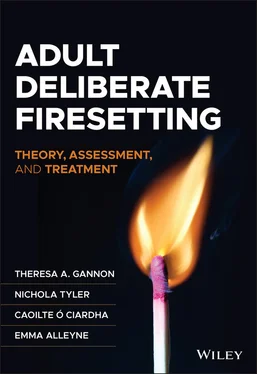Theresa A. Gannon - Adult Deliberate Firesetting
Здесь есть возможность читать онлайн «Theresa A. Gannon - Adult Deliberate Firesetting» — ознакомительный отрывок электронной книги совершенно бесплатно, а после прочтения отрывка купить полную версию. В некоторых случаях можно слушать аудио, скачать через торрент в формате fb2 и присутствует краткое содержание. Жанр: unrecognised, на английском языке. Описание произведения, (предисловие) а так же отзывы посетителей доступны на портале библиотеки ЛибКат.
- Название:Adult Deliberate Firesetting
- Автор:
- Жанр:
- Год:неизвестен
- ISBN:нет данных
- Рейтинг книги:5 / 5. Голосов: 1
-
Избранное:Добавить в избранное
- Отзывы:
-
Ваша оценка:
- 100
- 1
- 2
- 3
- 4
- 5
Adult Deliberate Firesetting: краткое содержание, описание и аннотация
Предлагаем к чтению аннотацию, описание, краткое содержание или предисловие (зависит от того, что написал сам автор книги «Adult Deliberate Firesetting»). Если вы не нашли необходимую информацию о книге — напишите в комментариях, мы постараемся отыскать её.
Explore the theoretical foundations of—and discover effective treatment options for—adults who deliberately set fires Adult Deliberate Firesetting: Theory, Assessment, and Treatment,
Adult Deliberate Firesetting: Theory, Assessment, and Treatment
Adult Deliberate Firesetting — читать онлайн ознакомительный отрывок
Ниже представлен текст книги, разбитый по страницам. Система сохранения места последней прочитанной страницы, позволяет с удобством читать онлайн бесплатно книгу «Adult Deliberate Firesetting», без необходимости каждый раз заново искать на чём Вы остановились. Поставьте закладку, и сможете в любой момент перейти на страницу, на которой закончили чтение.
Интервал:
Закладка:
There has since been a shift away from focussing on the firesetting–violence link towards developing the understanding of the more proximal causes of firesetting behaviour. Root et al. (2008) explain that juvenile firesetting may be the outcome of child abuse and its resulting affective and behavioural difficulties. The DSM-5 views firesetting behaviour as a feature of conduct disorder in children. That is, deliberately setting fires to destroy property (note animal cruelty as well) is a diagnostic criterion for conduct disorder—“a repetitive and persistent pattern of behaviour in which the basic rights of others … are violated” (APA, 2013).
The child literature has also offered some insight into the dynamic risk factors associated with firesetting behaviour. For example, as a result of neglectful parenting styles (Slavkin, 2000) as well as the previously mentioned abusive household environments, children and adolescents who set fires develop impoverished and unsophisticated interpersonal social abilities. These abilities form the basis of their dysfunctional attachment styles (Räsänen et al., 1996). These relational issues have since been captured in the adult literature. Most notably, adults (in particular men) who set fires exhibit signs of loneliness with limited and/or unhelpful social support networks (Rice & Harris, 2008). Maladaptive attachment styles are associated with offending more broadly (e.g., Ross & Pfäfflin, 2007; Ward et al., 1996), and their role in reinforcing offending behaviour makes them highly suitable targets for treatment in adults.
In sum, this literature tells us that childhood firesetting points to maladaptive and dysfunctional childhood environments conducive of offending behaviour. But more important, it appears that a history of firesetting behaviour during childhood may be a risk factor for future firesetting in adulthood (Ducat et al., 2015). Therefore, the firesetting behaviour itself is indicative of a developmental psychopathology that supports the use of fire as a coping strategy and/or problem-solving method. This conceptualisation has been captured in the latest theories (see Chapter 3) and has significant implications for assessment (see Chapter 4) and treatment (see Chapters 6and 7).
Sexual Offending Literature as a Guiding Framework
Given the paucity of the adult firesetting literature pre-2010, researchers turned to more established literatures (i.e., sexual offending) to inform the research agenda moving forward. However, although early theorising suggested a relationship between firesetting and sexual dysfunction, little available evidence substantiates this link as a major explanatory factor for adult firesetting (Ó Ciardha, 2015). Research on sexual offending has nonetheless been influential in developing knowledge relating to firesetting. This is likely the result of the longstanding recognition of sexual offending—particularly child sexual abuse—as a public health problem in need of sustained research to develop knowledge for prevention and treatment. As a result, the burgeoning field of research on deliberate adult firesetting has been able to draw on practices and concepts from the more established field of research on sexual offending.
A key influence of the field of sexual offending on firesetting research has been work by Tony Ward and various collaborators. The Multi-Trajectory Theory of Adult Firesetting (M-TTAF; Gannon et al., 2012) is an example of theorising in firesetting that draws inspiration from work, including that of Ward and Beech (2006), Ward and Hudson (1998), and Ward et al. (2006), on how to effectively develop, appraise, and knit together theories in sexual offending. Models of the offence process (micro theories) of firesetting behaviour (e.g., Barnoux et al., 2015; Tyler et al., 2014) also used methods applied by Ward et al. (1995) to the investigation of the offence process of people who sexually offend against children. Furthermore, Ward hypothesised that implicit theories (Ward, 2000; Ward & Keenan, 1999) and offence scripts (Ward & Hudson, 2000) form part of an explanatory framework for the offence-supportive belief systems of people who commit sexual offences. These concepts have been highly influential in theory development (e.g., Butler & Gannon, 2015; Ó Ciardha & Gannon, 2012; see Chapter 3) and empirical research (e.g., Barrowcliffe et al., 2019; Butler & Gannon, 2021) on firesetting behaviour.
Changes and developments in the treatment of sexual offending over the past number of decades have also influenced current practice in the treatment of firesetting. For example, those interested in best practice with people who have sexually offended have been confronted with questions around dealing with clients who deny or minimise their offending. Similarly practice regarding treatment of sexual offending has had to navigate whether treatment ethos is most effective using a risk-based or a strengths-based approach. Building from the evidence base around what works for sexual offending has allowed contemporary intervention programmes for people who have been apprehended for firesetting (see Chapters 6and 7) to be developed, conscious of principles of risk, need, and responsivity (Andrews & Bonta, 2010) and strength-based approaches to treatment (Good Lives Model; Ward & Stewart, 2003). These intervention programmes have been able to avoid the pitfalls faced by early sexual offending practice whereby denial and minimisation posed barriers to treatment involvement (Maruna & Mann, 2006).
Book Rationale
This chapter has provided some of the context surrounding the emergence, in the past decade and a half, of research on deliberate adult firesetting as a coherent field of enquiry. Given the relative nascence of this field, some may ask whether an entire book devoted to the assessment and treatment of adults who set fires is necessary.
At times, firesetting has been viewed as one behaviour amongst a broad repertoire of offending, whereby the individual is generally antisocial (i.e., the generalist hypothesis ; Gannon et al., 2013). There is some research evidence to suggest that people who set fires are likely to also commit other types of offences (e.g., Soothill et al., 2004), and they are more likely to recidivate in ways other than firesetting (see Chapter 4). Based on these findings, it could be argued that firesetting does not warrant special attention. However, there is a growing body of evidence that support the specialist hypothesis —that some people who set fires do not commit other forms of offending—or that people with firesetting convictions may represent a distinct population within correctional settings (Gannon et al., 2013). In other words, it appears that many individuals with a history of adult firesetting have distinct psychological and psychopathological features (see Chapter 2) that require a more tailored approach to treatment. Such targeting of these likely criminogenic needs is fundamental to the effectiveness of forensic clinical practice (see Bonta & Andrews, 2017).
The fact that emerging literature suggests that people who set fires represent a population within the criminal justice and healthcare systems that experience specific needs demonstrates how our understanding of deliberate adult firesetting has changed in a short period of time. We argue that this book is timely because it allows us to synthesise the findings of a rapidly expanding field while highlighting where the gaps remain in our knowledge and where new ways of working are needed in terms of the data that public agencies and researchers gather; the manner in which researchers approach hypothesis testing around the aetiology, assessment, and treatment of people who set fires; and the ways in which practitioners work with this population.
Читать дальшеИнтервал:
Закладка:
Похожие книги на «Adult Deliberate Firesetting»
Представляем Вашему вниманию похожие книги на «Adult Deliberate Firesetting» списком для выбора. Мы отобрали схожую по названию и смыслу литературу в надежде предоставить читателям больше вариантов отыскать новые, интересные, ещё непрочитанные произведения.
Обсуждение, отзывы о книге «Adult Deliberate Firesetting» и просто собственные мнения читателей. Оставьте ваши комментарии, напишите, что Вы думаете о произведении, его смысле или главных героях. Укажите что конкретно понравилось, а что нет, и почему Вы так считаете.












